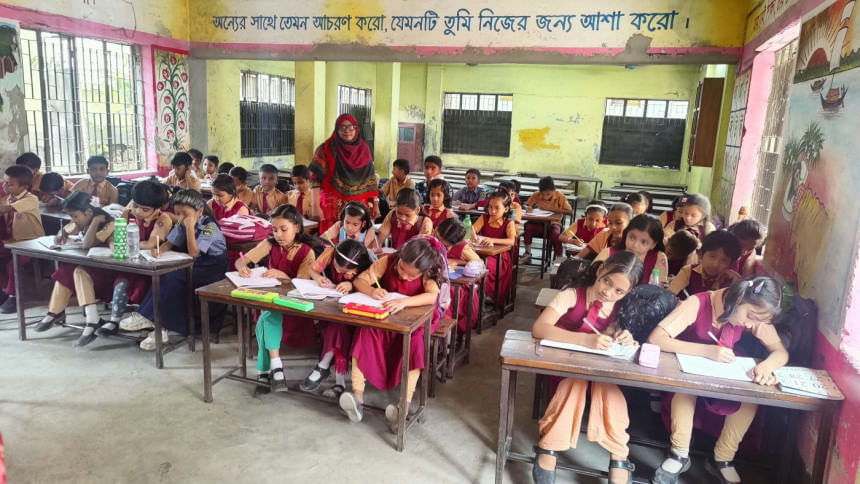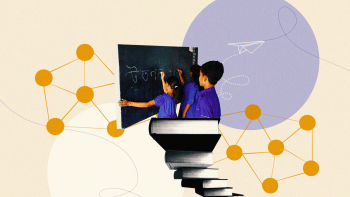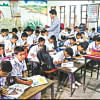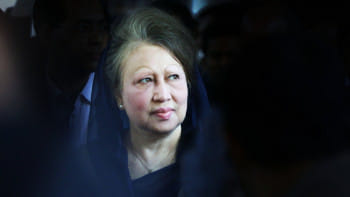Bangladesh needs better education infrastructure to prevent primary dropouts

In Bangladesh, physical infrastructure is still a major challenge in ensuring a safe and child-friendly learning environment, as well as quality primary education in the country. Educational infrastructure includes school buildings, classrooms, teachers' rooms, furniture, water and sanitation facilities, playgrounds and boundary walls. According to the Annual Primary School Statistics (APSS) 2024, there were a total of 118,607 schools under which 65,567 (55.3 percent) were government primary schools, and the rest were kindergartens, NGO-run schools and religious schools, providing primary education in Bangladesh. There were 383,624 teachers in government primary schools in 2024, of whom 252,704 were female. Primary education in Bangladesh consists of six classes—pre-primary to grade 5—with a total enrolment of about two crore students in 2024 across Bangladesh.
According to the APSS 2024, 13,519 (20.4 percent) government primary schools in Bangladesh operate on a single-shift basis. This means that four out of every five schools (79.6 percent) continue to operate on a double-shift basis. Over the years, the student-teacher ratio has improved in government primary schools; it was 1:28 in 2023. However, classroom congestion (student classroom ratio among the division ranged from 28 to over 37), along with the high prevalence of double-shift schools, affects the academic performance, resulting in a high proportion of children dropping out.
The government is committed to converting all double-shift primary schools to single-shift schools. The objective is to improve quality, inclusivity and equity in primary education by increasing contact hours. In double-shift schools, learning time is short, creating inequality in the delivery of education. To address the weakness posed by the current double-shift system, the number of classrooms needs to be increased, as there is a huge shortage of classrooms. At the same time, the number of teachers in government primary schools must be increased.
In Bangladesh, between 30 and 32 lakh children are born every year. The net enrolment rate was 94.55 percent in 2024. The country is yet to achieve the 100 percent enrolment target. A total of 52,048 government primary schools are currently operating on a double-shift basis, and the number of classrooms must be increased to convert the remaining double-shift schools to single-shift schools, as per the standards set out in the Infrastructure Planning Guidelines adopted by the Directorate of Primary Education in 2018. The guidelines aim for a reasonable student-classroom ratio to prevent overcrowding.
Through the fourth Primary Education Development Programme (PEDP4), the government planned to build 50,500 classrooms, teachers' rooms and head teacher rooms, many of which are still under construction. The number of single-shift schools increased from 9,112 in 2017 to 13,519 in 2024. This is considered slow progress towards the targeted achievement of 100 percent single-shift schools in the country.
Over the past decade, Bangladesh has significantly reduced dropout rates in primary education, aligning with Sustainable Development Goal 4 (SDG 4). The dropout rate is a crucial indicator of success in primary education. Although the dropout rate decreased significantly between 2010 and 2024 from 39.8 percent to 16.25 percent, compared to last year (13.15 percent) the rate increased slightly. Boys have a higher dropout rate than girls across all grades. The increase in the dropout rate is alarming, meaning a significant portion of children are not completing the full primary education cycle. One reason for the high dropout rate cited in the APSS 2024 is rising living costs due to inflationary pressures, which leads to families prioritising short-term economic survival over continued schooling for their children. The sharp increase in the dropout rate among boys—from 14.12 percent in 2023 to 19.02 percent in 2024—may have been caused by early entry into the labour market. In that case, child labour in the country is likely to rise. Compared to boys, girls' dropout rate rose marginally from 12.32 percent to 13.36 percent between 2023 and 2024. For both genders, classroom congestion and the prevalence of a high percentage of double-shift schools can also be contributing factors to the increased dropout. These factors significantly limit quality contact hours, leading to low academic performance.
The high proportion of double-shift schools reflects challenges that should be overcome by increasing the primary education budget to convert all double-shift schools to single-shift schools, ensuring sufficient classrooms, and recruitment of more teachers. In the current fiscal year's national budget (2025-2026), planned education sector outlays constitute 12.1 percent of the total budget (Tk 95,644 crore), of which primary education has been allocated Tk 35,403 crore. This is not adequate for building sufficient educational infrastructure, including the construction of new classrooms, as well as the reconstruction, repair and maintenance of existing schools. This will impact the achievement of the desired academic outcome. The education sector budget received around 1.72 percent of GDP in 2025-26, which is much lower than 4-6 percent, recommended by the Education 2030 Framework for Action. It is a global document, adopted by UNESCO Member States in 2015, providing guidelines for the implementation of SDG 4. To achieve SDG 4 by 2030, the government must take all required measures to regain the progress made towards universal basic education, including raising the amount of educational stipend, involving students and parents in school planning and management, investing in all aspects of school infrastructure, prompt recruitment of teachers, and undertaking educational campaigns.
Particular attention must be given to primary school teachers' training to improve educational quality. The 67 primary training institutes (PTIs) and 505 upazila resource centres in the country play a vital role in enhancing primary school teachers' capacity, ensuring that new teachers are equipped with the necessary skills and knowledge to effectively teach at the primary level. The PTIs are also involved in curriculum development, monitoring the quality of primary education, identifying areas for improvement and promoting the expansion of primary education access. However, many PTIs do not have enough training rooms and hostels. Some are housed in very old buildings that require reconstruction. The situation of upazila resource centres is similar, with many requiring additional training rooms and offices to run smoothly. Therefore, along with the primary schools, primary teachers' training centres and primary school education offices need proper infrastructure to work smoothly for the upliftment of primary education in Bangladesh.
Dr Nawshad Ahmed, a retired UN official, is an economist and urban planner. He is currently working as the team leader in a primary school infrastructure need assessment project for the Department of Primary Education, Dhaka. He can be reached at [email protected].
Views expressed in this article are the author's own.
Follow The Daily Star Opinion on Facebook for the latest opinions, commentaries and analyses by experts and professionals. To contribute your article or letter to The Daily Star Opinion, see our guidelines for submission.

 For all latest news, follow The Daily Star's Google News channel.
For all latest news, follow The Daily Star's Google News channel. 











Comments